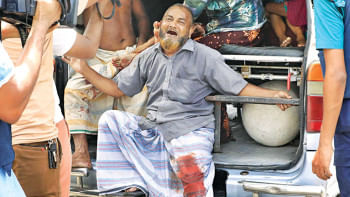Household income, expenditure nearly triple in 12 years

Monthly average household income and expenditure in Bangladesh doubled in the last six years and nearly tripled in 12 years, official figures showed yesterday.
The average monthly household income rose to Tk 32,422 in 2022, up more than 102 per cent on 2016, according to the latest data from the Bangladesh Bureau of Statistics (BBS).
The average monthly income was Tk 15,988 in 2016 and Tk 11,479 in 2010.
On the other hand, monthly average household expenditure increased to Tk 31,500 in 2022, up 100 per cent from Tk 15,715 in 2016. It was Tk 11,200 in 2010, said the national statistical agency as it released the key findings of the "Household Income and Expenditure Survey 2022".
The BBS said income and expenditure of households in rural and urban areas increased in the last 12 years. But households in urban areas registered higher income than expenditure in 2022.
In case of rural households, it is opposite.
In 2022, average monthly income of a rural family was Tk 26,163, which was higher than monthly expenditure of Tk 26,842 of a rural household.
"As the poverty is higher in rural areas, it is only logical that their expenditure will be higher than their incomes," said Mustafa K Mujeri, a former director-general of the Bangladesh Institute of Development Studies (BIDS).
The poverty rate in rural areas is 20.5 per cent and it is 14.7 per cent in urban areas, BBS data showed.
"It indicates that the government should work more to reduce poverty in rural areas and create additional opportunities for the people who have been left behind," Mujeri said.
Riding on steady economic growth in the past two decades, Bangladesh has made significant progress in many social indicators, cut the poverty rate, and raise calorie intake. However, income inequality has widened.
The Gini Coefficient related to income rose to 0.499 in 2022, up from 0.482 in 2016 and 0.458 in 2010, BBS data showed.
The BBS conducted the survey among 14,400 households from January 1 to December 31 last year.
Debapriya Bhattacharya, a distinguished fellow at the Centre for Policy Dialogue, thinks the data collection period is important.
"The data may have been collected in the early part of 2022 when the economy was witnessing a post-covid recovery, albeit fragmented, so this has possibly led to project a brighter development achievement," he said.
"The reference period of the survey may not cover the second part of 2022 when the economy was experiencing the initial adverse pressure of the war in Ukraine and global economic stress."
According to the economist, one should, instead of average achievement figures, take a disaggregated look by income categories of the households.
"This will reveal the wide disparity underlying the average figures."
Bhattacharya said this would be particularly relevant given that income inequality has increased over the last decade as testified by the newly reported Gini index.
The Gini index measures the extent to which the distribution of income or consumption among individuals or households within an economy deviates from a perfectly equal distribution. A Gini index of 0 represents perfect equality, while an index of 100 implies perfect inequality.
"There is also an alternative truth that is coming from micro studies, perceptions and views of people who have been left behind. These views and perceptions often challenge the averages obtained through national census data," Bhattacharya added.
Mujeri, also the executive director of the Institute for Inclusive Finance and Development, said income inequality has been rising for many years though the poverty rate dropped successfully and the GDP is growing.
"It means the growth is not fully inclusive and we are lagging behind when it comes to improving the living condition of the people who have been left behind."
The economist recommended creating more opportunities for the poor and the marginalised. "From the government side, additional and effective policy and approach is needed."
The poverty rate has declined to 18.7 per cent and the extreme poverty rate stood at 5.6 per cent in 2022, according to the BBS.
In 2016, the poverty rate was 24.3 per cent and the extreme poverty rate was 12.9 per cent.
The coronavirus pandemic might have had some short-term effects on poverty, pushing up the rate. But the survey showed the poverty rate has fallen over the years, said Mujeri.
While speaking at the release of the key findings at the BBS headquarters in Dhaka, Planning Minister MA Mannan credited the government's various steps taken during the pandemic for the reduction in the poverty rate.
"The initiatives have paid off."
The government enforced partial lockdowns during the second wave of Covid-19 outbreaks in 2021, so the production and livelihood were functional, he said.
According to the key findings of the survey, electricity access reached 99.32 per cent in 2022, up from 75.92 per cent and 55.26 per cent in 2016 and 2010, respectively.
About 92.21 per cent of households have improved toilet facilities and 96.1 per cent have access to drinking water.
According to the HIES, the literacy rate of people aged more than seven years jumped to 74 per cent last year. It was 65.6 per cent and 57.91 per cent in 2016 and 2010, respectively.
State Minister for Planning Prof Shamsul Alam said the number of ultra-poor people reduced quickly thanks to huge government assistance.
"I have never seen such a huge amount of government assistance reaching the rural level."
Many government programmes such as test relief and the Food for Work are operational and people were given to cattle, sewing machines, and food support, he said.
"The ultra-poor people used to work in the agriculture sector. Now we see a shortage of labour in the sector. This is because these people are moving to the non-agriculture sector where jobs are available."
Binayak Sen, director general of the BIDS, said rural inequality has narrowed while urban inequality has widened. As a result, in the overall Gini Index, inequality has been increased.
The BIDS conducted surveys to find out the factors for the rise in inequality in rural areas between 2000 and 2010.
"We found that inequality deepened because of self-employment. People who had access to capital or education were advancing while those who did not have such access fell behind," Sen said.
"If we carry out an analysis for the period between 2010 and 2022, we will find out the real reason."


 For all latest news, follow The Daily Star's Google News channel.
For all latest news, follow The Daily Star's Google News channel. 






Comments